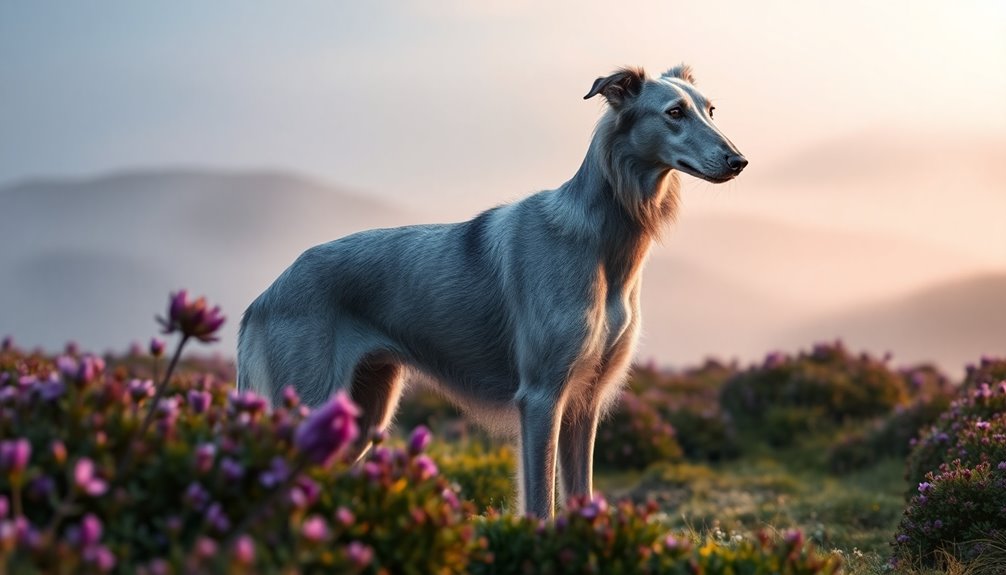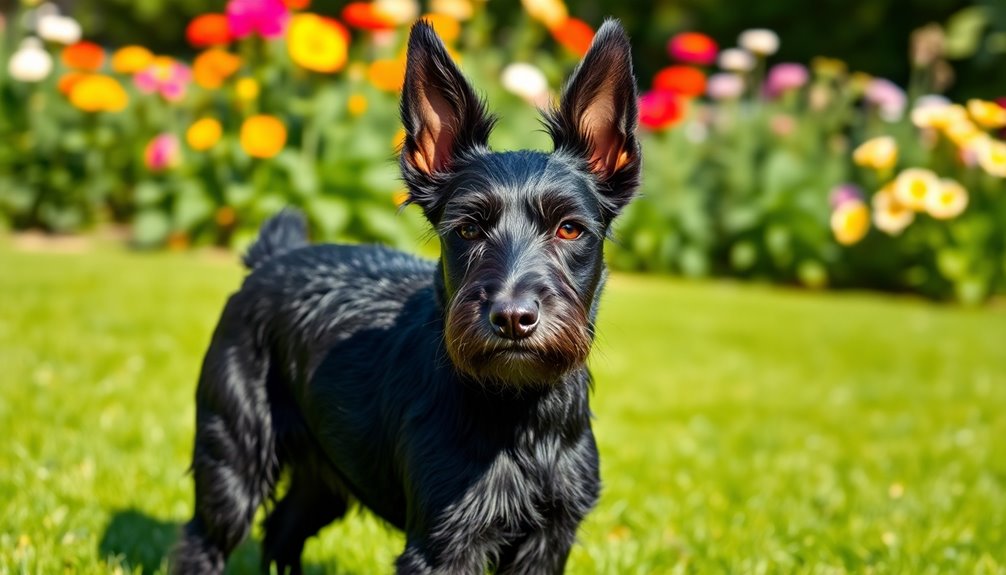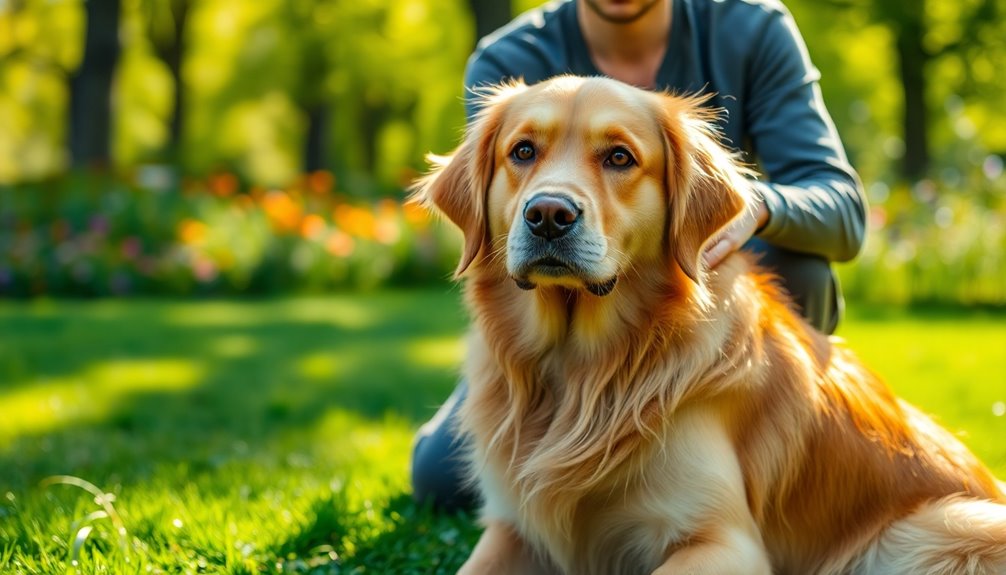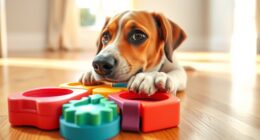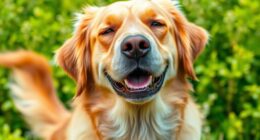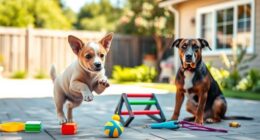The Scottish Deerhound is a majestic breed that's known for its elegance, loyalty, and gentle demeanor. Standing tall with an aerodynamic body, these gentle giants typically weigh between 75 to 110 pounds. Their affectionate nature makes them perfect companions, especially for families. They thrive on companionship and enjoy ample exercise, requiring about 1.5 to 2 hours daily. While they're generally docile, early socialization is key for adapting well to other pets. Their rich history adds to their appeal, and there's much more to discover about these regal dogs' suitability for your home.
Key Takeaways
- Scottish Deerhounds are elegant, with a regal appearance and aerodynamic body, making them visually striking gentle giants.
- They possess a docile and affectionate temperament, thriving on companionship and being great family pets.
- With a history rooted in nobility, they were prized for hunting large game, showcasing their loyalty and strength.
- Regular exercise and grooming are essential for their well-being, requiring at least 1.5 to 2 hours of activity daily.
- Their average lifespan is 8 to 11 years, with health management focusing on early detection of breed-specific issues.
Introduction

The Scottish Deerhound's regal appearance and gentle nature make it a beloved breed among dog enthusiasts. Standing impressively tall, males reach heights of 30 to 32 inches, while females start at 28 inches. Weighing between 85 to 110 pounds for males and 75 to 95 pounds for females, these dogs possess an aerodynamic body designed for speed, featuring a deep chest and narrow waist. Their wiry coat comes in varying shades, including gray, fawn, and brindle, adding to their striking look.
Temperament-wise, Scottish Deerhounds are dignified, docile, and extremely affectionate with their families. They're known for being easygoing and quiet, making them a great addition to a home. While they get along well with children, mild supervision is recommended due to their size. In terms of social behavior, they are rarely aggressive and are prized for their hunting abilities and gentle demeanor.
However, they're not particularly friendly with small pets and aren't considered suitable guard dogs. Socially, these gentle giants thrive on companionship and prefer not to be left alone.
With medium trainability and a playful spirit, they require regular exercise to channel their energy. Overall, the Scottish Deerhound is a loyal, loving breed that fits well into family life.
History and Origin
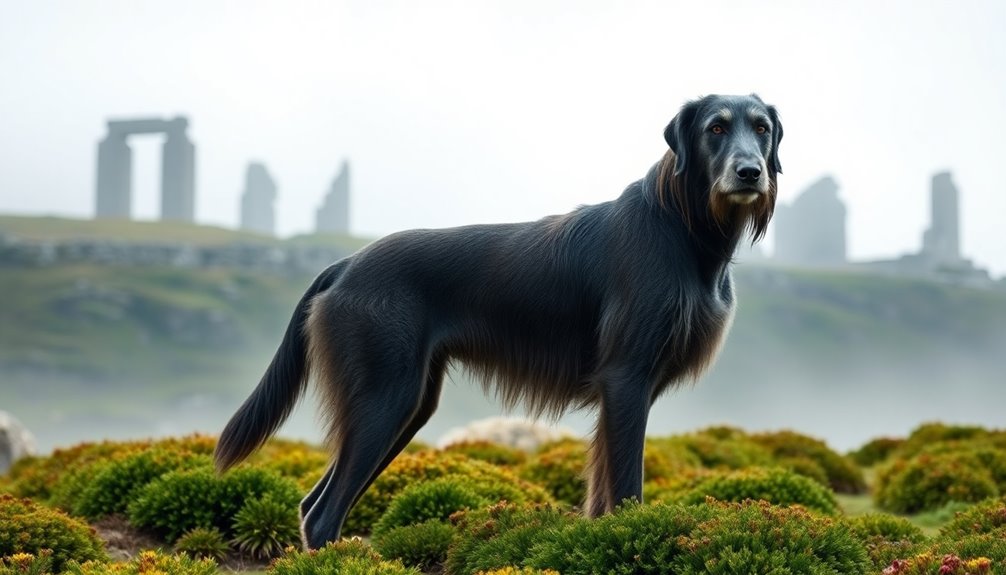
The Scottish Deerhound has ancient roots, tracing back to the Dark Ages, where early depictions on Pictish stones suggest a lineage tied to Greyhound-like dogs.
These majestic sighthounds were prized companions for noble hunters, playing a crucial role in royal game hunting across northern Britain. Historically, ownership of the breed was restricted to earls and higher ranks, highlighting their esteemed status in society.
Understanding their history helps you appreciate the breed's significance in both sport and society.
Where and when the breed originated
Often regarded as one of Scotland's noble breeds, the Scottish Deerhound has its roots deeply embedded in the Scottish Highlands. This majestic breed is tied to the ancient Scots and Picts, with some speculation suggesting they were introduced by Phoenician traders over 3,000 years ago.
Known by various names, including the Scotch Greyhound and Highland Deerhound, their lineage is closely associated with the Irish Wolfhound.
The Scottish Deerhound's history traces back to at least the 16th century, though it likely existed under different names prior to that. They're mentioned in the 1576 work "English Dogges," referring to Greyhounds, and by the 17th century, the term "Deerhound" became widely used. Their appearance resembles a large, heavier Greyhound, which adds to their noble stature.
Valued by the nobility, only those of earl rank or higher could own them, highlighting their significance in Scotland's clan system.
Their existence faced challenges, especially after the Battle of Culloden, but dedicated enthusiasts like Archibald and Duncan McNeill helped preserve the breed.
The Scottish Deerhound eventually made its way to the United States by the late 19th century, where it was recognized by the American Kennel Club in 1886.
Royal Game Hunting Companion
Regarded as one of the finest hunting companions of royalty, the Scottish Deerhound was bred specifically for the noble pursuit of stalking and capturing large game, particularly red deer. Exclusively owned by the nobility, only those ranked as earls or higher could possess these magnificent dogs.
Their hunting prowess made them highly prized among Scottish aristocrats, symbolizing power and prestige. Noble families often exchanged Deerhounds as gifts, which was considered a great honor.
These dogs were bred to hunt giant, wild red deer, with packs capable of bringing down 400-pound animals. Known for their endurance, courage, and speed, Deerhounds hunted by sight rather than scent, making them ideal for chasing deer across rugged terrain. They are also one of the largest dog breeds, with males capable of standing up to 32 inches at the shoulder.
However, changes in hunting practices nearly led to their extinction. The introduction of firearms reduced the need for their skills, and declining deer populations further threatened their existence.
Fortunately, dedicated breeders revived the breed after Queen Victoria's exhibition in 1869.
Today, while they primarily serve as gentle companions, they continue to excel in lure coursing and other dog sports, embodying their rich heritage and affectionate nature.
Physical Characteristics
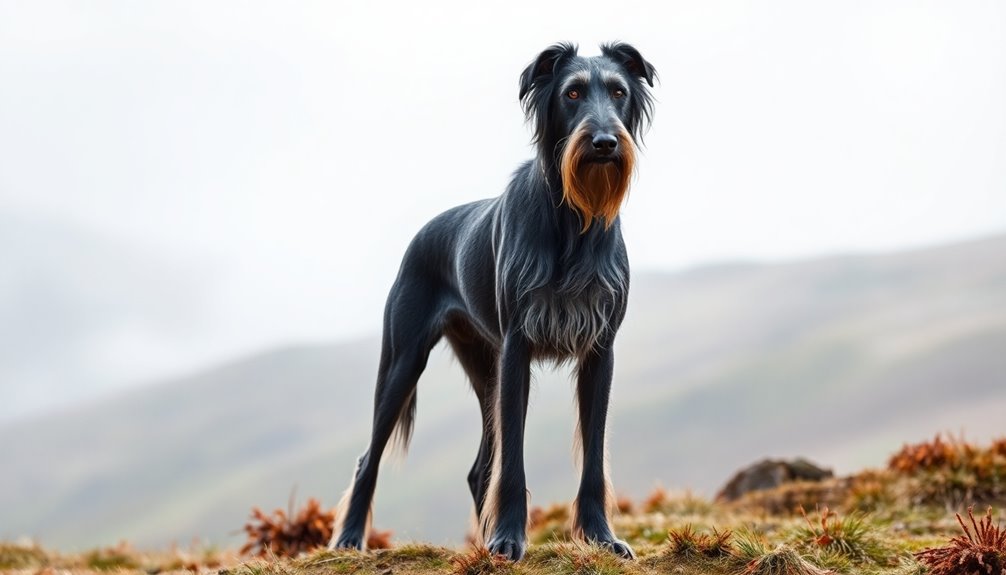
When you think about the Scottish Deerhound, you'll notice its impressive size and weight, with males standing between 28 to 32 inches tall and weighing up to 110 pounds.
Their medium-length, wiry coat comes in various shades, providing them with a weatherproof barrier against harsh conditions.
These physical traits not only contribute to their majestic appearance but also highlight their athleticism and endurance. Additionally, they prefer cold weather, which allows them to thrive in their natural habitat.
Size, weight, and coat details
The Scottish Deerhound is an impressive breed, known for its tall stature and graceful build. Males typically stand between 30 to 32 inches at the withers, while females range from 28 to 30 inches, making them one of the tallest dog breeds in the world.
You can expect males to weigh between 85 and 110 pounds, averaging around 100 pounds, while females usually weigh between 75 and 95 pounds, averaging about 80 pounds.
Their body structure features long, slender legs and a narrow frame, typical of the greyhound family. A deep chest and tucked abdomen enhance their elegant profile, complemented by an arched loin and a long tail.
The Deerhound's head is dolichocephalic, exhibiting a long face that's larger than that of a Greyhound. Their small, dark "rose" ears are soft and fold back against their head, perking up semi-erect when they're excited.
With their impressive size and refined features, Scottish Deerhounds truly stand out as gentle giants, embodying both elegance and strength. They are well-suited for rough terrain due to their development in the Scottish Highlands.
Long, Flowing, Wiry Coat
With a coat that's both striking and functional, the Scottish Deerhound showcases a long, flowing, wiry texture that sets it apart from many breeds. The outer coat, measuring 3 to 4 inches, consists of harsh, straight hairs that lay flat against the body, while the dense, soft undercoat provides crucial insulation against damp and cold weather. This unique coat protects you and your Deerhound from rough terrain and harsh elements. Additionally, this breed's medium coat length allows it to adapt well to various climates.
To keep your Deerhound's coat healthy, you'll need to brush it weekly using a slicker brush and metal comb. Make sure to brush the entire coat, including the legs, tail, and ears. During shedding seasons, which occur twice a year, increase your grooming frequency to prevent tangles and knots.
Although the wiry coat minimizes shedding, regular grooming is essential to avoid matting. Every few months, trim the coat to maintain its length and shape, using scissors and clippers with a guard to protect the skin. Don't forget to wash the beard frequently, as it tends to collect water after drinking.
In cold weather, consider a dog coat for added warmth, and ensure your Deerhound has access to shade and water in the heat.
Temperament and Personality
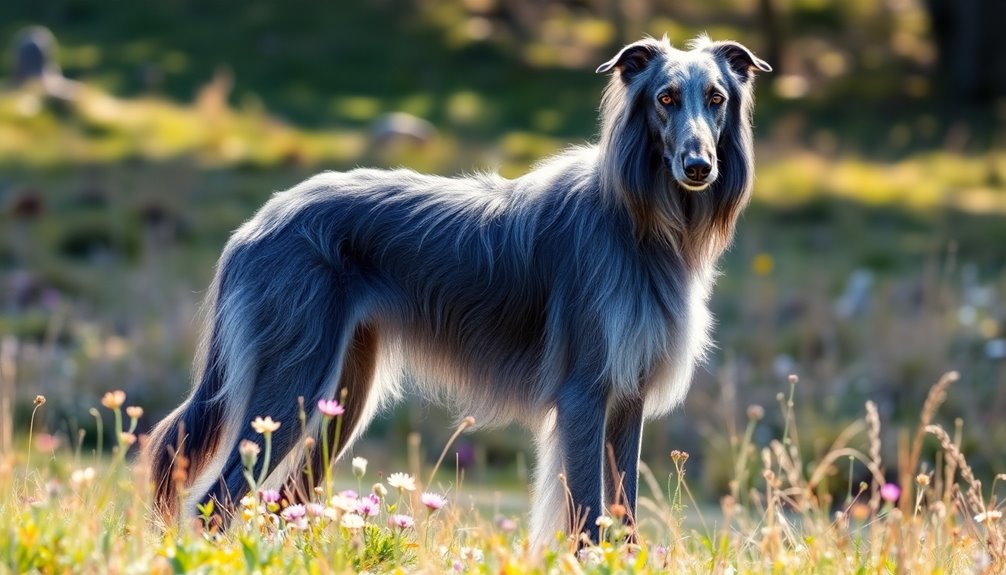
When you consider a Scottish Deerhound, you'll find a breed known for its gentle and patient demeanor. They're great for families, individuals, and can even get along well with other pets, especially if raised together. With their affectionate nature, you'll appreciate how they thrive on companionship and attention from their loved ones. Additionally, due to their mild-mannered temperament, they exhibit a quiet disposition with minimal barking behavior, making them a peaceful addition to any household.
Gentle and Patient Demeanor
Scottish Deerhounds are known for their gentle nature, making them ideal companions for families. These dogs are friendly, yet they aren't overly gregarious, often taking a calm approach to new people. You'll find that they rarely show aggression and are responsive to strangers without being intrusive. Their mild-mannered demeanor makes it easy to get along with them, as they're sweet, gentle, and sensitive to your feelings.
Patience is another hallmark of the Scottish Deerhound. They're laid back and enjoy lounging around, often content to curl up for a good nap while watching the world go by. Additionally, their unique independent thinking may require pet owners to be particularly persistent and creative in their training methods.
Though they don't demand constant attention, they thrive on family affection. You'll appreciate that they're generally quiet and don't bark excessively, preferring cozy spots to stretch out and relax.
Training them requires patience, as they're independent thinkers who work based on a close bond rather than a desire to please. While they need consistency, positive reinforcement, and varied training routines, their calm and low-key nature means they're more content than energetic, making them wonderful companions for a relaxed household.
Suitability for families, individuals, or other pets
The gentle and patient nature of the Scottish Deerhound makes them a great fit for families, individuals, and even other pets. They're incredibly affectionate and loyal, thriving on human interaction. However, they dislike being left alone for long periods, so if you're gone too often, they may become destructive.
For families with older children, they can be wonderful companions, but be cautious with younger kids due to their size. Proper interaction is essential to avoid accidents. Scottish Deerhounds are known for being part of the family dynamic, which enhances their bond with children and adults alike.
Scottish Deerhounds need plenty of space to roam and play. They're best suited for homes in the countryside or suburban areas, as they require regular exercise to manage their energy levels. If you live in an apartment, this breed may not be for you.
As for other pets, they generally get along well with medium or large dogs but may chase smaller ones due to their strong prey drive. Early socialization is crucial to ensure they adapt well to their environment.
If you're ready to provide attention, space, and exercise, a Scottish Deerhound can be a loyal and loving addition to your family.
Health and Lifespan
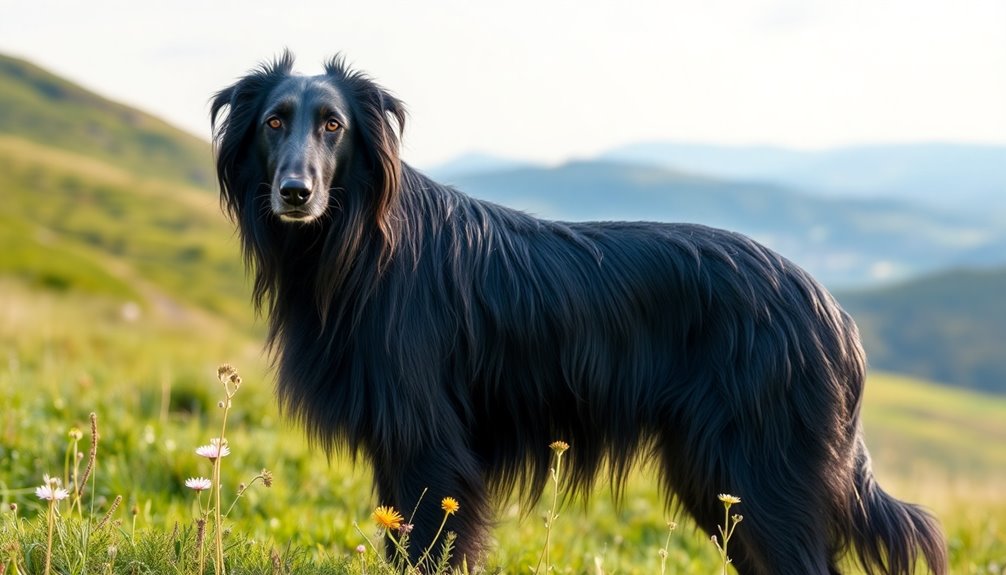
When it comes to the health and lifespan of your Scottish Deerhound, you should be aware of their average lifespan of 8 to 11 years and the common health issues they face. Conditions like osteosarcoma and dilated cardiomyopathy are prevalent in the breed, so being proactive about their care is essential. Additionally, larger breeds like the Scottish Deerhound may face increased risk of genetic health problems due to their size.
Typical lifespan of the breed
With an average lifespan of 8 to 11 years, Scottish Deerhounds exhibit notable variability in longevity. Recent studies from the UK suggest a life expectancy of around 10.5 years, while historical data reveals that males typically live 7.6 years and females 9.5 years.
Although the average lifespan for this breed is lower than that of purebreds (12.7 years) and crossbreeds (12 years), some Deerhounds can live beyond 14 years, with rare cases reaching up to 16 years and 9 months.
Factors influencing lifespan include genetics, exercise, diet, and overall temperament. Choosing a breeding stock from long-lived parents can enhance longevity, while moderate exercise without overexertion is essential. Additionally, hereditary influences are significant for longevity, as key health issues such as DCM, osteosarcoma, and GDV can impact lifespan.
Providing a balanced diet and clean water also contributes to a longer life. A happy, stress-free environment is crucial for their well-being, and timely medical interventions can significantly extend their lifespan.
While some Deerhounds may sadly pass away before reaching 6, most live between 6 to 9 years. Gender differences show that females generally outlive males, and regional studies further highlight these lifespan variations.
Common health concerns or genetic predispositions
Scottish Deerhounds face several common health concerns that can impact their overall lifespan and quality of life. One significant issue is osteosarcoma, a type of bone cancer prevalent in the breed due to a single dominant genetic factor.
Additionally, cystinuria can affect your dog's kidneys, while a genetic predisposition to slow drug metabolism may complicate treatment. You should also be aware of delayed bleeding, often linked to a deficiency in Factor VII, and the increased risk of hyperthermia due to their size. Regular check-ups are especially important for giant breed dogs like the Scottish Deerhound, as they are prone to various health complications.
Cardiac health is another concern, with dilated cardiomyopathy (DCM) being common in giant breeds. Regular veterinary check-ups are essential for early detection of symptoms like lethargy and difficulty breathing.
Gastrointestinal issues, particularly bloat, can also pose serious risks; deep-chested Deerhounds are especially vulnerable. Signs of bloat require immediate veterinary care.
Skin allergies, parasites, and the potential for tumor spread from osteosarcoma are additional health issues you need to monitor.
To ensure your Scottish Deerhound leads a healthy life, regular veterinary exams and proactive health management play crucial roles.
Tips for maintaining health and wellness
To maintain the health and wellness of your Deerhound, establishing a routine that includes regular veterinary check-ups is essential. These visits help detect potential health issues early, allowing for timely interventions that can significantly improve your dog's quality of life. Ensure your vet is familiar with the breed's specific health needs for the best care.
A balanced and nutritious diet tailored to your Deerhound's needs is crucial. Choose high-quality dog food rich in proteins, healthy fats, vitamins, and minerals. It's also important to be aware of the breed's predisposition to cardiomyopathy and schedule regular heart screenings as recommended by your veterinarian.
Regular exercise keeps your Deerhound physically and mentally stimulated. Aim for daily long walks, off-leash runs, or interactive play sessions. Avoid excessive high-impact activities to protect their joints.
Grooming is also important; brush your Deerhound's coat several times a week and keep their ears, teeth, and nails clean. Regular dental cleanings as recommended by your vet are key to preventing health issues.
With proper care, you can help your Deerhound live a long, healthy, and happy life.
Care Requirements

Caring for your Scottish Deerhound requires attention to grooming, exercise, and diet.
You'll need to brush their coat regularly, ensure they get plenty of physical activity, and feed them a balanced diet to maintain their health. Regular grooming is essential to manage their wiry coat and prevent tangles.
Regular Brushing Required
Regular brushing is essential for maintaining the health and appearance of your Scottish Deerhound's coat. Aim for weekly brushing to keep the coat in top condition, as this helps eliminate dead hair and distribute natural oils.
If your dog has been romping through tall grass or woods, you may need to brush more frequently to remove debris. Regular grooming effectively manages shedding and keeps the coat neat and free of tangles.
To groom your Deerhound, use a slicker brush to tackle loose undercoat and any knots. A deshedding rake can help you remove the undercoat, while a stripping stone is handy for grooming the ears and other areas. Additionally, using high-quality bathing products is crucial due to the dog's skin sensitivity.
For trimming, you might consider using blenders or thinning shears to achieve a moderate length. If you prefer a shorter look, carding can be a useful technique.
Although the wiry double coat sheds minimally, it still needs regular attention. Alongside brushing, remember to occasionally bathe your dog when they get dirty, trim the paws for hygiene, and keep an eye on their ears for infections.
Proper grooming ensures your Scottish Deerhound remains healthy and looking its best.
Exercise requirements and energy levels
Grooming your Scottish Deerhound sets the foundation for understanding their overall care, including exercise requirements and energy levels. These graceful giants need at least 30 minutes of exercise twice a day, totaling 1.5 to 2 hours daily. This should include brisk walks, jogging, and off-leash running in secure areas, as sprinting is crucial for their well-being.
Engaging in activities like fetch, lure chasing, hiking, and cycling keeps them physically active and mentally stimulated. Off-leash running in a fenced area is vital to channel their instinctual desire to chase, while leash walks ensure safety. Additionally, regular exercise is critical for their physical health, mental well-being, and longevity.
For puppies under 18 months, avoid intense exercise; gradual buildup is essential to protect their developing bones. Older Deerhounds may prefer less strenuous activities, like walking or running beside a bike.
Regular exercise helps maintain a healthy weight, supports muscle development, and keeps joints healthy, minimizing obesity risks. Plus, it promotes mental well-being, reducing anxiety and behavioral issues. By understanding their exercise needs, you'll ensure your Scottish Deerhound remains a happy and healthy companion.
Feeding tips and diet recommendations
Feeding your Scottish Deerhound properly is essential for their overall health and well-being. Start with high-quality protein from animal sources like beef, chicken, turkey, and fish. These proteins are crucial for muscle development and maintaining optimal body functions.
Include protein-rich foods like heart and liver, which can address specific health needs.
Incorporate healthy fats, such as omega-3 and omega-6 fatty acids, from sources like flaxseed and fish oil. These fats support skin and coat health, brain function, and provide energy. Balancing these fatty acids is vital for your Deerhound's health. Additionally, feeding a raw diet can lead to improved digestion and overall vitality.
You can add small amounts of complex carbohydrates like sweet potatoes, brown rice, and vegetables. These provide sustained energy and fiber, which is important for a healthy digestive system. Additionally, vegetables and fruits offer essential phytonutrients.
Ensure your Deerhound's diet includes natural vitamins and minerals from bone and plant sources. Hydration is critical, so provide high-moisture foods and always have fresh drinking water available.
Offal can serve as a natural multivitamin due to its nutrient density, helping to round out their balanced diet.
Training and Socialization
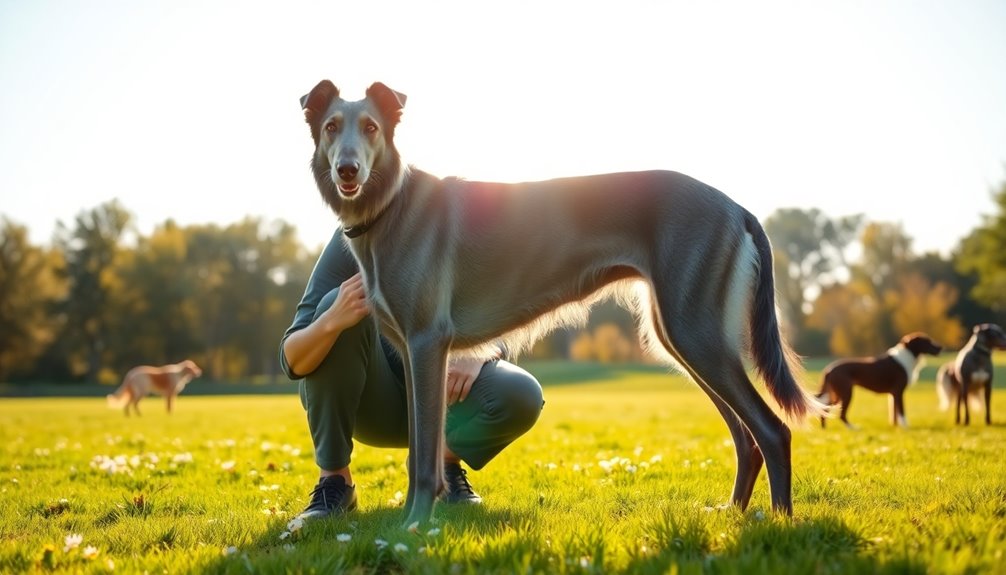
When training your Scottish Deerhound, you'll find they're moderately responsive to commands, so patience is key. It's essential to introduce them to diverse environments early on to help shape their reactions to new experiences. Additionally, leash training is crucial for these large dogs, ensuring safety during walks and outings. To foster a strong bond, effective training techniques, including positive reinforcement, can significantly enhance communication and obedience.
Moderately Responsive to Commands
Understanding the Scottish Deerhound's moderately responsive nature to commands is essential for effective training and socialization. These magnificent dogs, while intelligent, tend to have an independent streak, which means they mightn't respond immediately to your commands. You'll find that patience is key, as they often take their time to process instructions. To foster a positive training experience, use positive reinforcement techniques. Treats, praise, and playtime can be great motivators. Avoid harsh corrections, as they can harm your relationship and stall progress. Keep training sessions short—about 10-15 minutes—to maintain their focus, and incorporate lessons into daily activities like walks or meal times for practical learning. Additionally, retrieving skills take considerable time to develop, making fairness and patience essential throughout your training journey. Consistency in your approach is crucial. Make sure everyone in your household uses the same commands and rewards. Celebrate small victories to keep your Deerhound engaged, and be prepared for some setbacks along the way.
Introduce to Diverse Environments
Introducing your Scottish Deerhound to diverse environments is crucial for their development and confidence. Start this process as early as possible, ideally between 8 to 16 weeks. Early socialization shapes how your dog reacts to people, animals, and various stimuli while preventing issues like fearfulness and aggression.
Begin by exposing your Deerhound to quiet areas and gradually progress to busier settings. This method ensures they don't feel overwhelmed. Use treats and praise to reinforce positive behavior during these experiences. Additionally, providing ample space for movement is essential as Deerhounds thrive in environments where they can stretch their legs and explore.
Incorporate training into daily activities, like mealtimes or walks, to create practical learning opportunities. Interactions with different people and other dogs are essential. Introduce your Deerhound to individuals of various ages, genders, and ethnicities.
Puppy classes, dog parks, and playdates are great for developing their social skills. Always supervise these interactions to maintain a safe environment.
Leash Training for Large Dogs
Leash training is a vital part of socializing your Scottish Deerhound, especially given their size and strength. Start by choosing a comfortable harness with a chest attachment for better control. Let your dog sniff the leash and harness before attaching them to create a positive association. In a calm environment, introduce the equipment, rewarding your dog with treats and clicks for acknowledging it.
Begin training with short walks in distraction-free areas like your yard. Use positive reinforcement to encourage your dog to walk beside you without pulling. If the leash tightens, stop moving—this "Be a Tree" method teaches them to return to your side. Reward good behavior with treats and praise, and practice commands like "let's go." Consistent and firm training techniques are crucial for big dogs, as they help establish control.
If your Deerhound pulls, halt immediately and wait for them to come back. Use commands like "stop" when necessary, and redirect their attention by rewarding them for stopping.
Consistency is key; ensure everyone in your household uses the same commands. Incorporate training into daily routines, keeping sessions short and engaging. This approach will help your Deerhound become a well-adjusted and obedient companion.
Ideal Living Environment
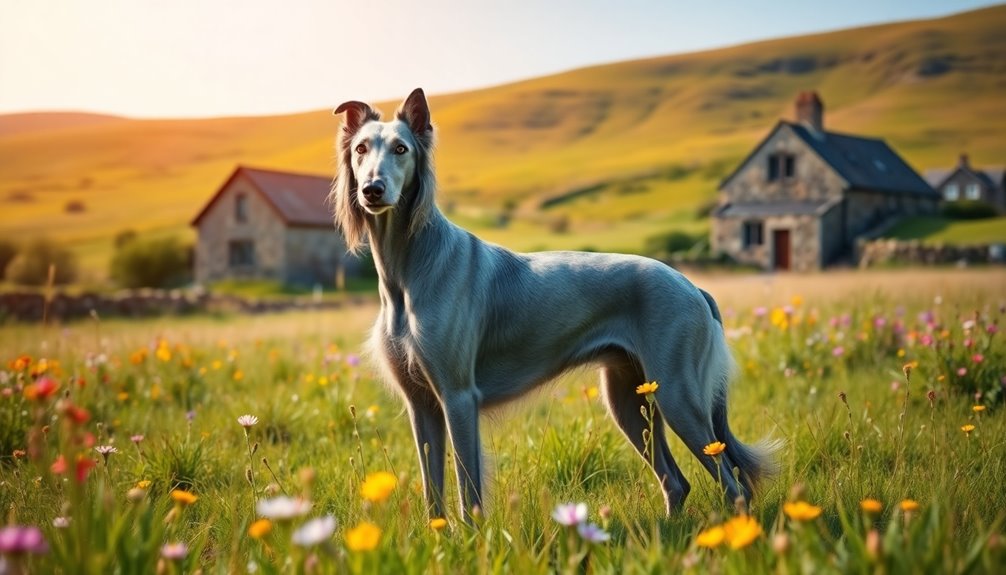
If you're considering a Scottish Deerhound, you'll need a spacious backyard where they can stretch their legs and play freely. These dogs thrive in cooler, temperate climates, so your living environment should accommodate their preference for cooler temperatures. Providing ample room for exercise and comfort is essential for their well-being. As a breed originally bred for hunting and coursing deer, they require plenty of space to roam and explore.
Spacious Backyard for Exercise
A spacious backyard is essential for a Scottish Deerhound's well-being, providing the freedom they need to run and play. These gentle giants require at least 1.5 to 2 hours of exercise daily, which includes brisk walks, jogging, or off-leash running in a securely fenced area.
Their strong prey drive means it's crucial to exercise them in a safe environment, preventing any chasing of small animals. Ensure your backyard is large and securely fenced, as Deerhounds can jump great heights. This space allows for unrestricted movement, letting your dog indulge in natural behaviors.
Puppies require shorter, controlled play sessions to protect their developing joints, while adults can reach full exercise levels by 18 to 24 months. Additionally, a spacious backyard helps mitigate destructive behaviors that stem from insufficient exercise. Regular walks are crucial for maintaining health and energy levels; an hour-long walk is insufficient for optimal health, as Deerhounds need daily off-lead exercise in secure areas to thrive.
If you work long hours or can't provide daily outdoor time, your Deerhound may become unhappy and restless. By offering ample room to roam and play, you create a nurturing environment that supports their physical and mental health.
Regular exercise will keep your Scottish Deerhound content, healthy, and well-adjusted.
Prefers Cooler, Temperate Climates
Scottish Deerhounds thrive in cooler, temperate climates, where their wiry coats provide essential protection against the chill. Their thick fur not only keeps them warm but also makes them prone to overheating in hot weather. That's why it's crucial to monitor their exposure during warmer months.
Schedule exercise during the cooler parts of the day, ensuring they always have access to fresh water and shade.
In cooler conditions, Deerhounds can enjoy outdoor activities, aligning with their historical role as hunters. They benefit from rigorous activity, like running and stretching their legs, without the risk of overheating. Additionally, their average lifespan is an important consideration, as they require consistent care and exercise throughout their lives.
Walking, play sessions, and free runs are vital for their exercise regimen, and safe, enclosed areas allow them to unleash their speed.
While Deerhounds are generally healthy, they can face issues like cardiomyopathy and bloat. Cold weather doesn't worsen these conditions, but you still need to keep an eye on their health.
Adequate exercise in cooler climates helps maintain their well-being. A comfortable resting place and regular interaction with you'll ensure they thrive, making your home a peaceful haven for these gentle giants.
High-Speed Runners in Short Bursts
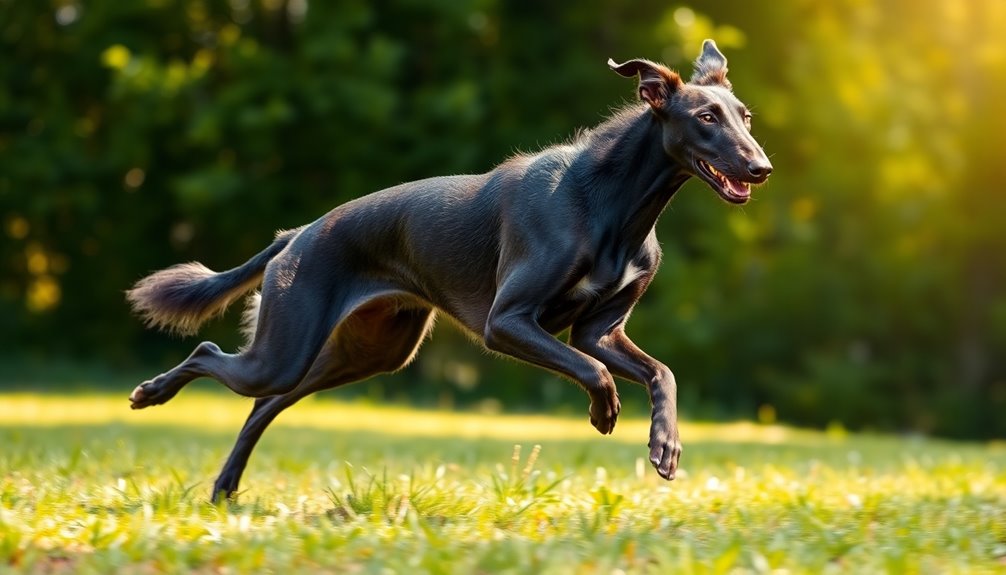
The Scottish Deerhound, known as an ancient royal hunting dog, showcases remarkable speed, especially in short bursts. You might remember its impressive agility from films like "The Last Samurai," where its swift movements are highlighted. This breed's ability to sprint makes it a fascinating subject in understanding high-speed runners. With a history rooted in hunting game, Deerhounds have developed their impressive speed to chase down prey in the wild.
Ancient Scottish Royal Hunting Dog
Originating from the rugged landscapes of Scotland, the Scottish Deerhound stands as a testament to centuries of selective breeding for hunting prowess. This noble breed traces its roots back to the Middle East, where Phoenicians introduced Egyptian sighthounds around the 10th century BCE.
Throughout the years, the Deerhound developed from old Gaelic hounds, finding its place among the regal pursuits of Scottish nobility. Recognized in the 16th and 17th centuries, the Scottish Deerhound earned the title 'Royal Dog of Scotland' for its exceptional skills in hunting large game, primarily red deer.
With its robust, athletic build and streamlined appearance, this large sighthound can reach impressive speeds of up to 35 miles per hour, showcasing its ability as a high-speed runner in short bursts. Males often stand around 32 inches at the shoulder and weigh up to 110 pounds.
Designed for endurance and agility, the Deerhound's long legs and lean physique enable it to excel in both hunting scenarios and lure coursing competitions. Historically, these dogs worked in packs, demonstrating courage and skill as they chased down wild deer across Scotland's vast landscapes. Additionally, the breed's natural hunting instincts make them highly suited for tracking and chasing game, further emphasizing their historical significance in hunting.
Hollywood's "The Last Samurai
In "The Last Samurai," audiences witness the intense clash between tradition and modernization, much like the high-speed bursts characteristic of a Scottish Deerhound in pursuit of its prey. Set in 19th century Japan, the film follows Nathan Algren, a former U.S. Army Captain hired to train the Imperial Army against a samurai rebellion. This conflict highlights the struggle between the disciplined samurai, led by Katsumoto, and the untested Imperial forces.
Algren's journey transforms him from a bitter soldier to a sympathetic figure who learns the samurai's values of loyalty and honor. The film's action sequences mirror the Deerhound's swift, calculated movements, showcasing both the beauty and tragedy of battle. The film's development began in 1992 with Interscope Communications, leading to an epic portrayal of this historical conflict. Additionally, the samurai warriors demonstrate remarkable endurance, similar to the effects of caffeine on athletic performance, which enhances focus and stamina.
The initial clash results in disaster for the Imperial Army, emphasizing the importance of tradition and respect for one's heritage. As Algren trains the soldiers, he realizes that modern warfare techniques alone won't suffice against the samurai's spirit.
The film culminates in a heartbreaking final battle, underscoring the samurai's bravery despite their defeat. Their honor remains intact, just like the noble Scottish Deerhound, whose grace and loyalty endear it to all who understand its true essence.
Gentle Giant for Active Families?
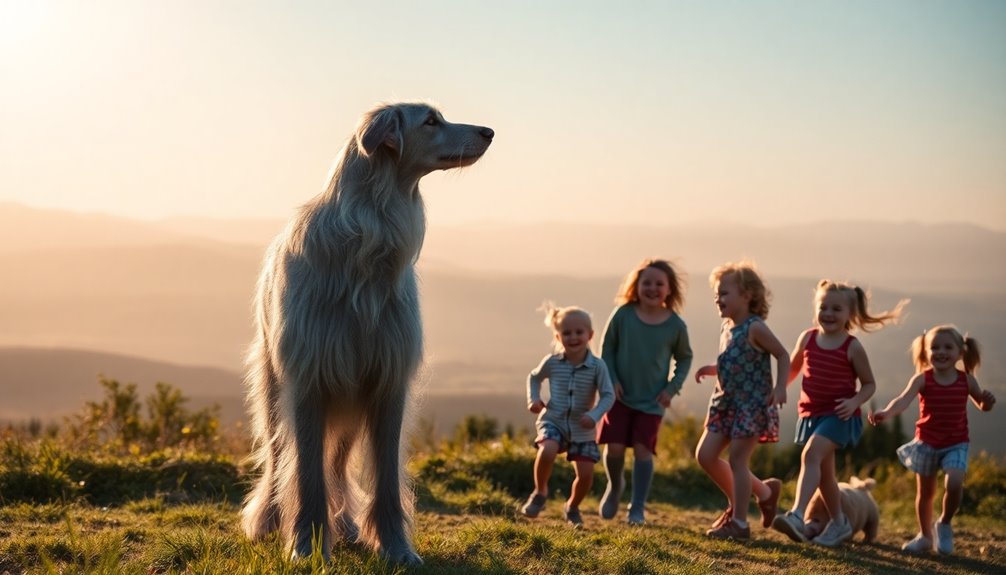
If you're an active family, the Scottish Deerhound could be the perfect addition to your home.
These gentle giants thrive on regular exercise and enjoy being part of your outdoor adventures. Their high-quality nutrition needs are essential to support their active lifestyle and overall health. Just keep in mind their grooming needs and space requirements to ensure a happy and healthy environment for everyone.
Ideal for Active Lifestyles
The Scottish Deerhound, often called the gentle giant, thrives in active households where both exercise and companionship are priorities. To keep your Deerhound happy and healthy, you'll need to provide at least 1.5 to 2 hours of exercise daily. This can include brisk walks, jogging, and off-leash running in a secure area. Given their high prey drive, it's crucial to ensure they're exercised safely to prevent them from chasing small animals.
A large, fenced-in yard or access to open spaces is ideal for free running, though they can adapt to apartment living with regular outdoor activities. Puppies require shorter, controlled exercise sessions, while adults enjoy long runs. As your Deerhound ages, you'll want to adjust the intensity of their exercise to maintain joint health. Additionally, these dogs are known for their calm and dignified temperament, which makes them great companions for families with children. This temperament can be enhanced by positive reinforcement training, creating a strong bond between you and your Deerhound.
In addition to physical activity, mental stimulation is essential. Engaging in training and interactive play helps channel their energy and promotes discipline. Activities like puzzle toys and obedience training can keep their minds sharp, reducing anxiety and behavioral issues.
With the right balance of exercise, training, and companionship, your Scottish Deerhound will seamlessly fit into your active lifestyle.
Grooming Needs and Maintenance
Keeping a Scottish Deerhound happy and healthy goes beyond exercise; grooming is a significant part of their care. These dogs have a double coat, featuring a wiry outer layer and a soft undercoat that insulates them against harsh weather. Their unique coat characteristics require regular attention to maintain its integrity.
To maintain their coat, you should groom them at least once a week, but more often during shedding seasons. Essential tools include a slicker brush, deshedding rake, and metal comb. Regular brushing distributes natural oils and prevents tangles.
Bathing should only occur when your Deerhound is very dirty or muddy, as frequent baths can strip their coat of essential oils. Use high-quality, gentle products to accommodate their sensitive skin. Conditioning sprays can help ease grooming sessions.
You'll also need to trim around the eyes and face for visibility and comfort. Keep the paw pads shaved and nails dremelled to ensure your dog's comfort.
Ear care is crucial, requiring regular checks to prevent infections. While the chest and hindquarters typically remain untrimmed, you can decide on specific styles based on personal preference.
Frequently Asked Questions
How Much Exercise Does a Scottish Deerhound Need Daily?
A Scottish Deerhound needs at least 1.5 to 2 hours of exercise daily.
You should aim for at least 30 minutes of activity twice a day, combining walks, playtime, and mental stimulation.
Consider brisk walks, jogs, or off-leash runs in secure areas.
Don't forget to adjust the routine based on their age and health, ensuring you provide safe environments to prevent accidents or injuries while exercising.
Do Scottish Deerhounds Get Along With Other Pets?
Scottish Deerhounds can be tricky around small pets due to their strong prey drive.
You'll need to supervise interactions closely, as they might chase after small animals, even if socialized.
With larger dogs, they often get along well, enjoying companionship in multi-dog households.
Just ensure proper socialization to keep things friendly.
When it comes to children, they can be gentle but always supervise to prevent accidents and promote safe interactions.
What Is the Average Cost of a Scottish Deerhound?
The average cost of a Scottish Deerhound ranges from $1,000 to $2,500 USD or £1,500 to £2,500 in some areas.
Prices can vary based on the breeder's reputation, location, and the puppy's lineage.
Factors like pedigree, litter size, and socialization efforts also play a role in determining the price.
Are Scottish Deerhounds Prone to Any Specific Health Issues?
Yes, Scottish Deerhounds are prone to several health issues.
You should be aware that osteosarcoma, a bone cancer, affects over 15% of them, often linked to a single dominant gene.
Cardiac problems like dilated cardiomyopathy can arise, showing symptoms like fatigue and difficulty breathing.
Additionally, bloat is a serious risk due to their deep-chested build.
Regular vet check-ups and attentive care can help manage these health concerns effectively.
How Can I Groom a Scottish Deerhound Effectively?
To groom your Scottish Deerhound effectively, start by brushing their coat weekly with a slicker brush to remove loose undercoat and prevent matting.
Bathe them only when necessary using a pH-balanced shampoo, and always brush before bathing.
Regularly trim around their paws, ears, and tail for a neat look.
Don't forget to clean their ears, clip nails, and maintain dental hygiene to keep them healthy and looking their best!
Conclusion
In summary, the Scottish Deerhound is an elegant and loyal companion, perfect for active families. With their impressive speed in short bursts and gentle demeanor, they thrive in a loving environment where they can run and play. By understanding their unique needs and providing proper training and socialization, you'll foster a strong bond with your gentle giant. Embrace the joy and companionship a Scottish Deerhound brings, and enjoy countless adventures together!

